23 Renoir Paintings That Still Turn Heads in 2025

Renoir paintings aren’t just stuck in the past — they’re still showing up in major exhibitions, art auctions and pop culture references more than a century later. According to Artsy, Renoir remains one of the top-selling historical artists on the global secondary market, with works regularly topping $10 million. That kind of staying power puts him in the same conversation as contemporary icons like Yayoi Kusama and Jeff Koons — artists who know how to hold the world’s attention.
But while Kusama gives you dots and Koons gives you chrome, Renoir gives you light. He painted people, parks and parties in a way that still feels human. Soft brushstrokes, warm palettes, scenes you can step into. Whether you’re learning about Impressionism or just wondering what the hype’s about, Renoir’s work is a good place to linger.
Jump to Section
- Pierre-Auguste Renoir: A Quick Look
- Understanding Renoir’s Painting Style
- Renoir Paintings: Early Impressionism
- Renoir Paintings: Mature Impressionism
- Renoir Paintings: Late Work & Post-Impressionism
- Renoir Paintings FAQs
Pierre-Auguste Renoir: A Quick Look
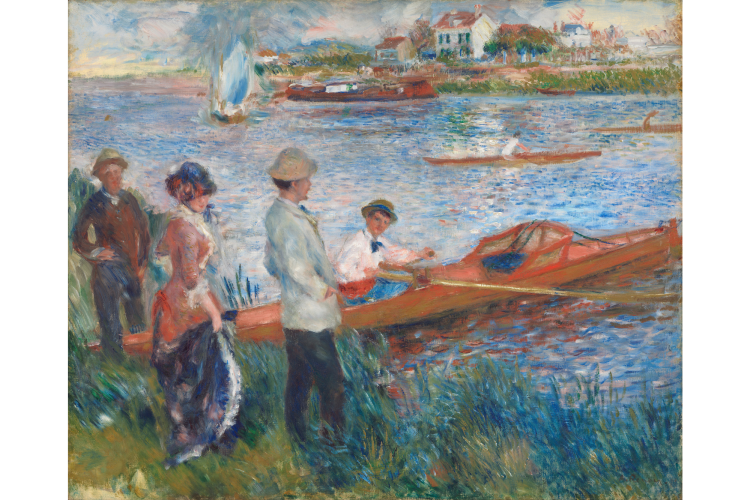
Pierre-Auguste Renoir was born in Limoges, France, in 1841 and became one of the defining figures of the Impressionist movement. Known for his colorful palette and soft brushwork, his paintings feel both timeless and intimate, capturing everyday scenes with warmth and ease.
He got his start decorating porcelain in his hometown before moving to Paris to study at the École des Beaux-Arts and later training in Charles Gleyre’s studio, where he crossed paths with Monet and other future Impressionists. In his later years, Renoir settled in the south of France near the Mediterranean, where he continued to paint despite severe rheumatoid arthritis.
He died in 1919 in Cagnes-sur-Mer at age 78, following a heart attack brought on by pneumonia, but not before leaving behind nearly 4,000 works and a legacy that still lights up galleries around the world.
Understanding Renoir’s Painting Style
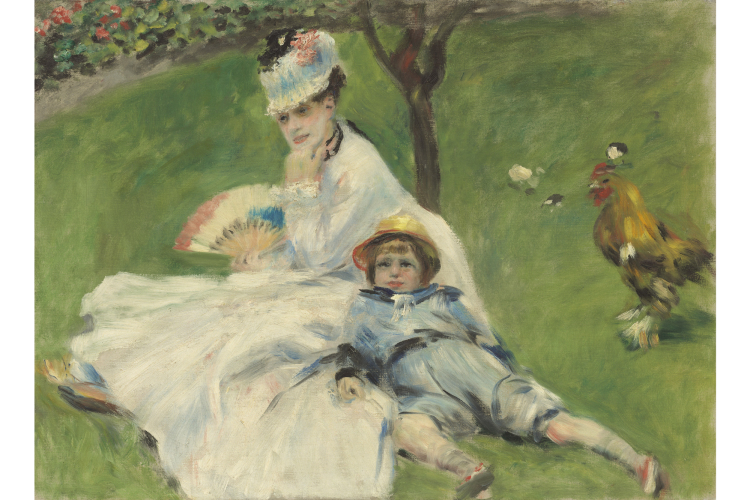
Renoir’s use of soft brushwork and glowing color has set him apart, making him one of the most famous painters of his time and in history. His scenes radiate warmth and intimacy, people laughing, strolling, lounging in sunlit gardens, all rendered with a light that feels alive.
He often painted alongside Oscar-Claude Monet — often referred to as Claude Monet — a French Impressionist painter and one of the founders of Impressionism. Monet and Renoir were contemporaries, and their art often influenced each other. Monet paintings, similar to Renoir paintings, portrayed landscapes and leisure activities. His philosophy was to capture an image as he saw it, even if that didn’t mean with complete accuracy.
So, if the two artists are similar, what is the difference between Monet and Renoir paintings? While Monet focused largely on landscapes and fleeting light, Renoir gravitated toward people, especially young women in sunlit scenes. His brushwork was smoother, his tones warmer. Where Monet dissolved form into haze, Renoir kept it intact but soft, inviting you in rather than holding you at a distance.
If you’re wondering how you can develop your art style, looking at the differences between artists is a good place to start.
Renoir Paintings: Early Impressionism
1. La Grenouillère (1869)

One of the earliest Renoir paintings in his professional career, La Grenouillère captures that boat-party-on-the-Seine vibe. Claude Monet also has a painting called La Grenouillère depicting the same scene. The two artists painted the scene at the same time, producing similar but distinct works of art.
You can find this Renoir painting today at the Stockholm Nationalmuseum.
2. La Loge (1874)

Another of Renoir’s early Impressionist paintings, La Loge depicts Nini Lopez in a Paris theatre box, casually posing with Renoir’s brother Edmond by her side. It hovers in prominent museum collections, and a version titled Au Théâtre, la loge sold through Christie’s for about $6 million, showing even his “slice-of-life” snapshots carry serious value.
3. La Parisienne (1874)

Renoir’s striking La Parisienne captures actress Henriette Henriot draped in a vibrant blue gown, her form emerging from an abstract, loosely brushed backdrop. Renoir painted this piece for the debut Impressionist exhibition in 1874, and he later softened its background to give it that iconic “floating” look. Today, it’s one of the centerpiece works of the National Museum Cardiff, affectionately known in Wales as The Blue Lady.
While not often available to purchase, “La Parisienne” has touched down in major exhibitions and Christie's estimates for similar large-scale Impressionist Renoir paintings have ranged in the mid-seven-figure zone.
4. Bal du Moulin de la Galette (1876)
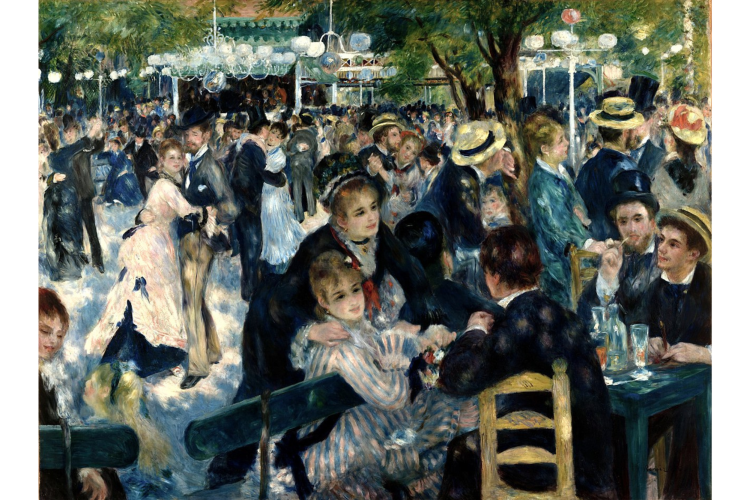
Renoir’s crown jewel from this era, and arguably one of the most famous Renoir paintings, the Moulin de la Galette is in Paris’s Musée d’Orsay. It’s often considered a masterpiece from the Impressionist movement. In the painting, you can see many intricately dressed men and women dancing, chatting and enjoying drinks. A smaller replica sold at Sotheby’s in 1990 for $78.1 million — a world‑record figure for Renoir.
5. Jeanne Samary in a Low Necked Dress (1874)
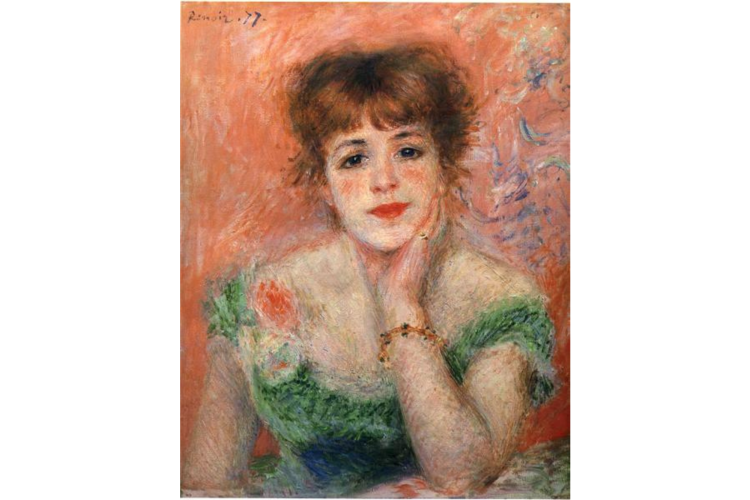
Also called The Daydream, this is pure early‑Era Renoir. It features young actress Jeanne Samary in a stunning blue gown dotted with flowers. It famously predates another 1878 portrait with even grander details. Samary lived close to Renoir’s home and he painted her multiple times. Another portrait, Portrait of Jeanne Samary in 1878, depicts the actress in a lavish gown.
6. Portrait of Claude Monet (1875)

Renoir didn’t just paint landscapes with Monet — he painted Monet himself, palette and brush in hand, gazing out a window. It highlights how both Impressionist artists often influenced each other. So, it’s no wonder that Portrait of Claude Monet is one of the most iconic Renoir paintings. This intimate portrayal lives in major museum collections (Musée d’Orsay often houses it), and is considered priceless, mostly kept in public hands.
7. The Skiff (1875)

Also known as La Yole, this serene scene of two women in a boat is the essence of middle‑class leisure in Paris. The painting depicts an idyllic scene on the water as a young woman rows her and her female companion across the vibrant blue water. In the distance are sailboats, lush greenery and a stately manor house. It cycles through museum exhibitions and scholarly features, though no high‑profile auction value is on record.
Renoir Paintings: Mature Impressionism
8. Luncheon of the Boating Party (1880-81)

Luncheon of the Boating Party (or Le Déjeuner des Canotiers in French) is arguably Renoir’s most celebrated masterpiece. It captures a convivial scene on Maison Fournaise’s balcony, filled with friends and patrons including Gustave Caillebotte and Aline Charigot, Renoir’s future wife. Today, this Renoir painting hangs at The Phillips Collection in Washington, D.C., acquired in 1923 for $125,000.
9. Two Sisters (On the Terrace) (1881)
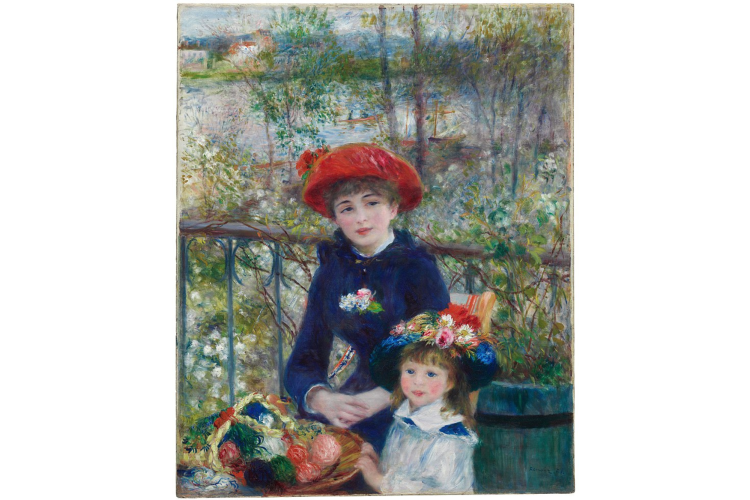
Two Sisters (or On the Terrace) belongs to Chicago’s Art Institute and shows two young girls (not actually sisters) seated on the terrace of a restaurant located on an island in the Seine called Maison Fournaise.
10. Pink and Blue (1881)

Often called Pink and Blue, this double portrait is officially titled Alice and Elisabeth Cahen d’Anvers. The painting depicts the sisters of wealthy patrons Louis Raphaël and Louise Cahen d’Anvers when they were five and six years old. It can be found today at the São Paulo Museum of Art, where it has been since 1952; it’s considered one of their most beloved paintings.
11. By the Seashore (1883)

By the mid-1880s, Renoir had stepped away from pure Impressionism and was embracing structure, form and a more classical influence. You can see that shift in By the Seashore, painted after a pivotal trip to Italy. Instead of the plein air spontaneity of his earlier work, this piece was likely completed in his studio and reflects a growing interest in balance and compositional harmony. The painting now resides in The Metropolitan Museum of Art in New York.
12. Moulin Huet Bay, Guernsey (1883)

This Renoir painting beautifully depicts leisure and landscape. Also from 1883, Moulin Huet Bay, Guernsey, is a landscape painting from his visit to the Channel Islands. In this painting, you can see him break away from some of the Impressionist techniques, focusing on the vibrant surf, playful figures and delicate rendering of water and sky. It’s currently part of the collection at the National Gallery in London.
13. Danse a la Ville (1883)
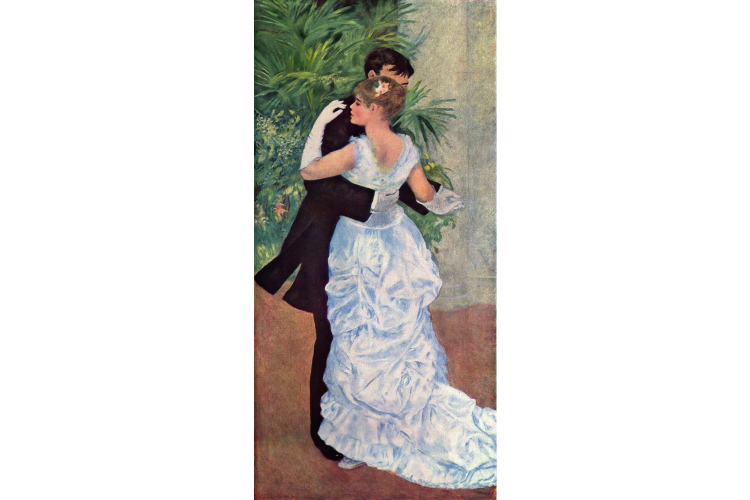
One of a series of Renoir paintings, this was commissioned by the art dealer Paul Durand-Ruel. Danse a la Ville or Dance in the City portrays a formally dressed couple, with Aline Charigot (Renoir’s future wife) in the starring role. The painting is held at the Musée d’Orsay in Paris.
14. Dance at Bougival (1883)

The second painting in the series is Dance at Bougival. It depicts a swirling couple mid-motion in a more casual setting in the village of Bougival, about 15 km from Paris. This painting can be seen in one of Boston’s art galleries, the Museum of Fine Arts.
15. Dance in the Country (1883)

The third in the series, Dance in the Country (in French, Danse à la Campagne), trades the urban backdrop for an outdoor setting beneath a chestnut tree, inspired by his trip to Italy and the inspiration from Renaissance art. The painting features Aline Charigot and Renoir’s friend Paul Lhôte, modelling the cheerful couple. This painting is also held at the Musée d’Orsay.
16. The Umbrellas (1881-86)

The Umbrellas reveals Renoir’s shift from airy Impressionism toward a more classical style. He began this painting between 1880 and 1881 with loose brushstrokes using dark and bright tones. However, as he lost attachment in later years, the painting was reworked to have a more classical linear style and more muted colors inspired by Italian Renaissance art. It alternates between display at London’s National Gallery and Dublin’s Hugh Lane Gallery as part of the Lane Bequest. There’s no public auction record. This painting stayed within institutional circles after being sold to Paul Durand-Ruel in 1892.
Renoir Paintings: Late Work & Post-Impressionism
Even as age and illness altered his technique, Renoir never stopped chasing softness, light and the female form — often reimagining classical scenes through an Impressionist lens.
17. The Great Bathers (1887)

Renoir continued refining this new style into his late period. The Great Bathers (Les Grandes Baigneuses in French) reflects his deepening interest in classical figuration. With its nude bathers and sculptural forms, it’s considered a turning point in his career. It’s one of the few Renoir paintings that depicts nude women bathing, with some women standing on the banks and others wading in the water. The influence of Italian painters like Raphael paintings, or those of the Veronese and Tiepolo, can be seen in the style of this painting. The painting is housed at the Philadelphia Museum of Art, where it remains one of the most studied works in the Impressionist galleries.
18. Two Young Girls at the Piano (1892)

In Two Young Girls at the Piano (or Jeunes Filles au Piano in French), Renoir’s return to domestic intimacy is clear. Commissioned by the French state, the original is in the Musée d’Orsay, though multiple variations exist. These variations of the same image include an oil composition and two sketches. These are on display in museums in Paris and the Metropolitan Museum of Art in New York City.
19. Maria Sert (1904)

This Renoir painting depicts Maria Sert (also known as Misia Sert) in a portrait, a muse of twentieth-century artists. Sert was a pianist and was often associated with other famous musicians, artists and writers in Paris. The portrait captures her glamorous and elegant demeanor as she sits on a chase and gazes towards the viewer. The painting is held at the National Gallery in London.
20. Self Portrait with a White Hat (1910)

Renoir rarely painted himself, which makes Self Portrait with a White Hat all the more personal. It offers a warm and humble view of the artist late in life, with dappled brushstrokes that still echo his Impressionist roots. The painting is held at the Musée d’Orsay.
21. The Bathers (1918-19)

The last of Renoir’s paintings, The Bathers (Les Baigneuses in French), depicts two groups of naked women. Two models lounge in the foreground while a group of three bathe in the background. Actress Andrée Hessling, the first wife of Renoir’s son, is one of the models for the painting. This final Renoir painting was completed in the year of his death.
Renoir Paintings FAQs
How many Renoir paintings are there?
Throughout his life, Renoir painted about 4,000 works. If you’re looking for Renoir paintings for sale, you’ll often have to pay a pretty penny at auction.
What is the difference between Monet and Renoir paintings?
Monet focused on landscapes and fleeting light, using broad, fragmented brushstrokes. Renoir emphasized human figures in social and intimate settings, using smoother strokes and warmer tones — more "in focus".
How much is an original Renoir worth?
The price for original Renoir paintings can reach well into the millions of dollars. Original Renoir paintings have sold for up to $24.4 million — most recently Berthe Morisot et sa fille, Julie Manet, which fetched $24.4 M at Christie’s New York in May 2022.
What disability did Renoir have?
Pierre-Auguste Renoir had rheumatoid arthritis, which made it difficult for him to hold a brush. This disability affected his precision and efficiency.
His arthritis led to hand deformities, elbow and back stiffness and abnormal bone fusions that affected his ability to stand. However, he did not let this stop him from creating and painting. He commissioned wheelchairs and seats that would position him comfortably in front of the canvas. His assistant would place the brush in his clenched hand. And he created a swiveling palette that affixed to a wheelchair.
You don’t need an art history degree to appreciate Renoir. He painted what he saw — and what he saw was joy, beauty and quiet moments that still feel familiar. Renoir paintings have hung in the world’s biggest museums, passed through the hands of billionaires and inspired generations of artists who followed.
If nothing else, Renoir’s work reminds us that a little warmth and softness can go a long way in art and in life.
For even more fun painting gift ideas, check out other experiences happening on Classpop!

